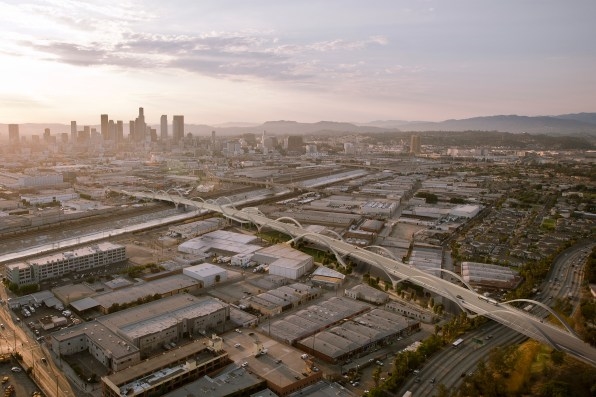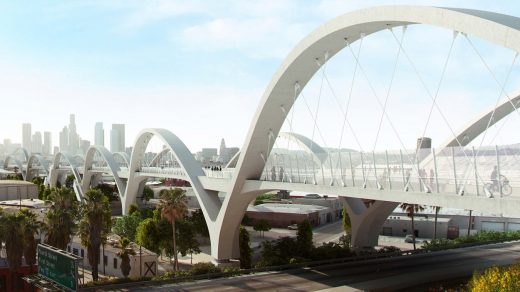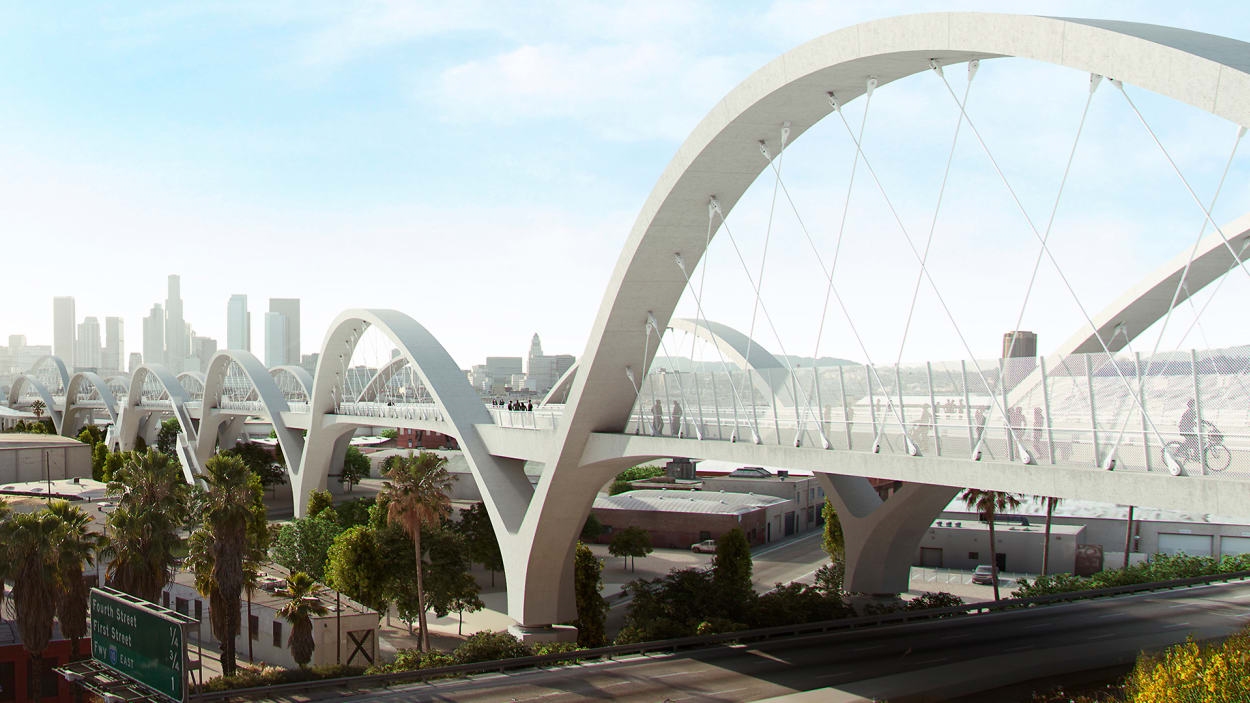L.A.’s massive new bridge is designed for 23 million pounds of people
The $588 million bridge opening this weekend in Los Angeles is a landmark piece of architectural infrastructure that’s becoming a signature part of the low-slung city’s skyline. With 10 swooping arches along its 3,500 feet, the Sixth Street Viaduct is as visually striking as it is massive.
But this huge new bridge—crossing over rail lines and the Los Angeles River between Boyle Heights and the Arts District—focuses on a smaller scale. In multiple ways, it was designed to be a people-first bridge.
Yes, there are the sidewalks and the bike lanes that have become expected in large civic infrastructure projects. But the bridge also includes some uncommonly people-focused design elements. There are five separate staircases that connect the bridge’s deck to the ground below. And at the bottom of those stairs is the site of what will be about 12 acres of a new public park—an amenity that further sets this bridge apart from other transportation-centric projects around the world. “We decided that it would be not only a mode of transportation but also a destination point,” says Michael H. Jones, project manager and lead bridge engineer at engineering firm HNTB, which led the team that designed and built the bridge

On top of all that, the bridge was also designed specifically to bear the weight of a massive crowd of people which, perhaps surprisingly, weighs a lot more than a string of 18-wheelers. Jones says the deck of the bridge is designed to carry a load of 90 pounds per square foot, or more than 23 million pounds total. If the bridge was going to be a destination, the thinking went, it better be able to handle a crowd. “The city’s plan for this project is to be able at some times to actually shut the bridge down and have celebrations,” Jones says.
The first is already scheduled. The Sixth Street Viaduct is having a grand opening this weekend, and the first day will be open to pedestrians only, with food, bands, and a capacity of 15,000 people.
It’s a party more than six years in the waiting. The original viaduct was built in 1932, and was one of 12 bridges built across the L.A. River at the time. Aside from being the longest, the Sixth Street Viaduct was also unique for the type of aggregate used in its concrete—one that was later proven to be susceptible to a degrading chemical reaction known colloquially as concrete cancer. “It literally eats the concrete up,” Jones says.
In seismically active Southern California, this was a problem. So the city’s Bureau of Engineering tore the original bridge down in 2016 and launched an international design competition to replace it.
The winning proposal, with a design by HNTB, in collaboration with L.A.-based Michael Maltzan Architecture, and Dissing+Weitling, is called the Ribbon of Light, and it features a wave of 10 arches along each side of the 3,500-foot-long bridge. With a width of 100 feet, the bridge has four vehicle lanes bordered by wide bicycle and pedestrian paths. Five separate staircases connect the bridge to the ground, where the park will be built over the next few years, including athletic fields, dog parks, picnic areas, a café, and a small performing arts plaza.
And while pedestrian access and public space became focal points of the design, the project’s core purpose was to make a bridge that wouldn’t fall down in an earthquake. Jones says the bridge has been designed to be particularly resilient in the face of seismic events, and is expected to withstand a 9.0 earthquake, which scientists predict happens only once in a thousand years. Key to this is the bridge’s use of seismic isolation bearings at the base of each arch’s connection point with the ground. These bearings act as a kind of buffer on which the bridge can stand, allowing the ground to move underneath during an earthquake without tearing apart the structure. “Because of the seismic isolation, the structure will be able to ride out that earthquake without any damage whatsoever,” Jones says.
The isolation bearings were specially designed for this project, but have already been used in other settings. Jones says the same system has been implemented in the construction of SoFi Stadium, the $5.5 billion football stadium in nearby Inglewood.
In addition to improving the bridge’s strength, the bearings also changed its structural requirements. Jones says the bridge deck was able to be designed as a single structure, without the need for costly expansion joints at various points. “We believe that actually cut the cost of the structure down,” he says. “The bearings more than paid for themselves.”
(12)



